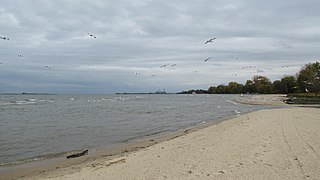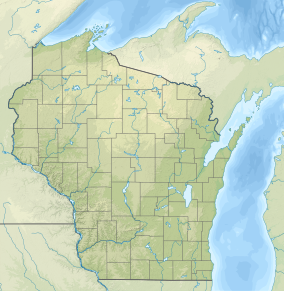
The Rock River is a tributary of the Mississippi River, approximately 299 miles (481 km) long, in the U.S. states of Wisconsin and Illinois. The river was known as the Sinnissippi to Sauk and Fox Indians; the name means "rocky waters".

Southwick Beach State Park is a New York State park that lies along an unusual stretch of sandy beach on the eastern shore of Lake Ontario. The park is 464 acres (188 ha) in size with a 3,500 foot (1,100 m) length of beach, and is visited annually by about 100,000 people. Immediately to the south is the Lakeview Wildlife Management Area, which extends the publicly accessible beach by several miles. They are in the Town of Ellisburg in Jefferson County, New York south of the lakeside community of Jefferson Park.

The Kankakee River is a tributary of the Illinois River, approximately 133 miles (214 km) long, in the Central Corn Belt Plains of northwestern Indiana and northeastern Illinois in the United States. At one time, the river drained one of the largest wetlands in North America and furnished a significant portage between the Great Lakes and the Mississippi River. Significantly altered from its original channel, it flows through a primarily rural farming region of reclaimed cropland, south of Lake Michigan.

The Driftless Area, a topographical and cultural region in the American Midwest, comprises southwestern Wisconsin, southeastern Minnesota, northeastern Iowa, and the extreme northwestern corner of Illinois.

Aransas National Wildlife Refuge is a 115,324-acre (466.7 km2) protected area situated on the southwest side of San Antonio Bay along the Gulf Coast of the U.S. state of Texas. It is located in parts of Aransas, Refugio, and Calhoun Counties. It is situated on the southwest side of the San Antonio Bay, formed by the mouth of the Guadalupe River. It also includes nearly the entirety of Matagorda Island, a 38-mile barrier island. The Aransas National Wildlife Refuge was established by Executive Order 7784 on 31 December 1937 by President Franklin D. Roosevelt as the Aransas Migratory Waterfowl Refuge as a refuge and breeding ground for migratory birds and other wildlife. Roosevelt issued a proclamation in 1940 changing the name to the Aransas National Wildlife Refuge.

Savanna Portage State Park is a state park of Minnesota, USA, established in 1961 to preserve the historic Savanna Portage, a difficult 6-mile (9.7 km) trail connecting the watersheds of the Mississippi River and Lake Superior. The portage trail crosses a drainage divide separating the West Savanna River, which drains to the Mississippi River and the Gulf of Mexico, from the East Savanna River, which flows in an opposite direction to the Saint Louis River, Lake Superior and the Great Lakes, and the Saint Lawrence River to the Atlantic Ocean.

The Sweetwater River is a 55-mile (89 km) long stream in San Diego County, California.

Bay City State Park is a 2,389-acre (967 ha) state park located on the shore of Saginaw Bay near Bay City in Bay County, Michigan, United States. The Tobico Marsh, one of the largest remaining freshwater, coastal wetlands on the Great Lakes is located in the park. Other natural features of the park include a mile of sandy beach, over 2,000 acres (810 ha) of wetland woods, meadows, oak savannah prairies, and cattail marshes. The park is a haven for migratory birds and wetland wildlife.

Horicon Marsh is a marsh located in northern Dodge and southern Fond du Lac counties of Wisconsin. It is the site of both a national and a state wildlife refuge. The silted-up glacial lake is the largest freshwater cattail marsh in the United States.

Pikes Peak State Park is a state park of Iowa, US, featuring a 500-foot (150 m) bluff overlooking the Upper Mississippi River opposite the confluence of the Wisconsin River. The park is operated by the Iowa Department of Natural Resources. It is nearly a thousand acres (4 km²) in extent. The nearest city is McGregor, Iowa. Iowa Highway 76 approximately defines its northern boundary.

The Mobile–Tensaw River Delta is the largest river delta and wetland in Alabama. It encompasses approximately 260,000 acres (110,000 ha) in a 40-by-10-mile area and is the second largest delta in the contiguous United States. This large river delta is approximately 45 miles long and averages 8 miles wide, being 16 miles wide at its widest point. It covers approximately 300 square miles. Of its 260,000 acres, 20,000 acres consist of open water, 10,000 acres of marsh, 70,000 acres of swamp; and more than 85,000 acres of bottomland forest. It drains an area of about 44,000 sq miles, which includes 64% of Alabama and small portions of Georgia and Mississippi.

The Dewey Marsh is a state wildlife area in Portage County, Wisconsin, United States.
Banner Marsh State Fish and Wildlife Area is an Illinois state park covering 4,363 acres (1,766 ha) in Fulton County, Illinois, United States.

The Great Texas Coastal Birding Trail is a state-designated system of trails, bird sanctuaries, and nature preserves along the entire length of the Texas Gulf Coast in the United States. As the state of Texas hosts more bird species than any other state in the U.S. the trail system offers some of the most unusual opportunities for bird-watching in the world. The "trail" is actually 43 separate hiking and driving trails that include 308 birding sites. The sites themselves feature a variety of viewing opportunities with boardwalks, observation decks, and other amenities. The trails boast more than 450 bird species. The trail system is managed by the Texas Parks and Wildlife Department as part of the Great Texas Wildlife Trails which also include the Heart of Texas Wildlife Trail, the Panhandle Plains Wildlife Trail, and the Prairies and Pineywoods Wildlife Trail.

Theresa Marsh is located near Theresa, Wisconsin, in northern Washington County and eastern Dodge County. The marsh is the starting point for the Rock River, a tributary of the Mississippi River, and the marsh is an important stopping point for migratory birds. The Theresa Marsh Wildlife Area is a 5,990-acre (2,420 ha) state park that includes grassland, cattail, brush marsh, woodlands, agricultural land, seasonally flooded wetlands, and permanent wetlands. There are several campgrounds in the area. The Allenton State Wildlife Area is nearby.
The Leola Marsh Wildlife Area is a 1,875 acres (759 ha) tract of protected land located in Adams County, Wisconsin, managed by the Wisconsin Department of Natural Resources. The Wildlife Area was founded at the same time as the Buena Vista Wildlife Area and the Rachel Carson National Wildlife Refuge, located in Portage County, Wisconsin and Cumberland County, Maine respectively.
The Gardner Swamp Wildlife Area is a 1,180 acres (480 ha) tract of protected land located in Door County, Wisconsin, managed by the Wisconsin Department of Natural Resources. Land to be used for the Wildlife Area was first acquired in 1958, and the master plan for the Wildlife Area was completed in 1980.

The Powell Marsh Wildlife Area is a 4,850-acre (19.6 km2) tract of protected land located in Vilas and Iron counties, Wisconsin, owned and partially managed by the Wisconsin Department of Natural Resources (WDNR). The wildlife area is bordered by the Northern Highland-American Legion State Forest and Manitowish Chain O Lakes to the north, east, and west and the Lac du Flambeau Reservation to the south.
The Swan Lake Wildlife Area is a 2,466 acres (998 ha) tract of protected land located in Columbia County, Wisconsin, managed by the Wisconsin Department of Natural Resources (WDNR). Land to be used for the wildlife area was first acquired in 1963 to provide for hunting and other outdoor recreational activities in the county. In addition to outdoor recreation activities, the wildlife area was established to protect the Fox River watershed.
The Amberg Wildlife Area (AWA) is a 1,190-acre (480 ha) tract of protected land located in Marinette County, Wisconsin, managed by the Wisconsin Department of Natural Resources (WDNR). The wildlife area is surrounded by other protected areas, operated by either the county or other WDNR lands. The property was established in 1948, primarily to protect rare swamp conifer land, made up of 90-100 year old white cedar. The wildlife area is split up into two land management areas, the 909-acre (368 ha) native community management area of the Amberg Swamp Conifers and the eponymous 299-acre (121 ha) habitat management area.














